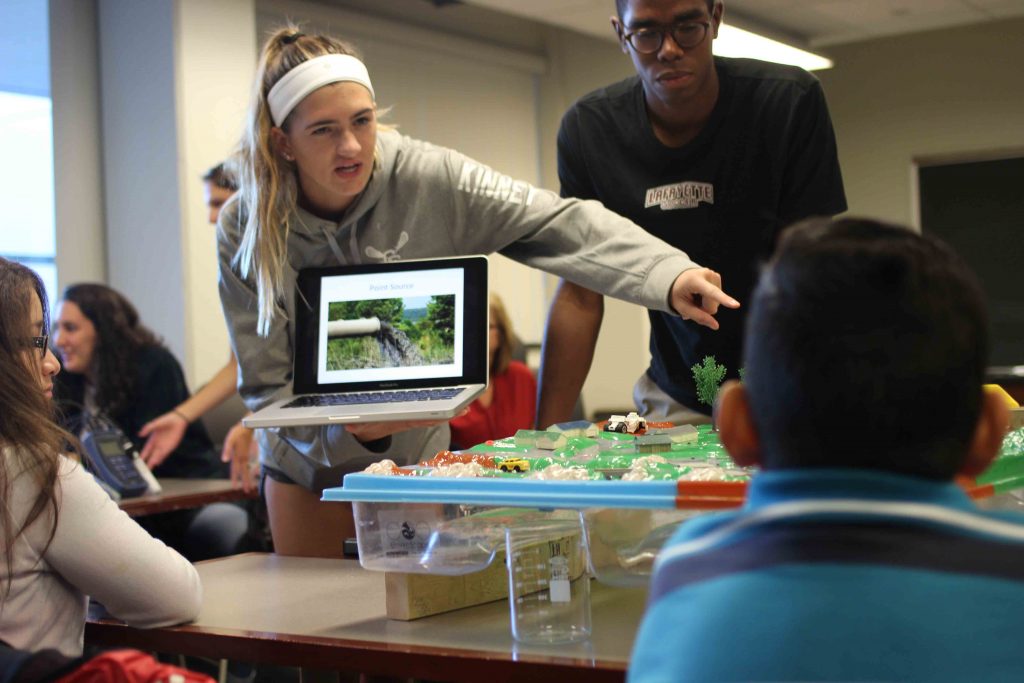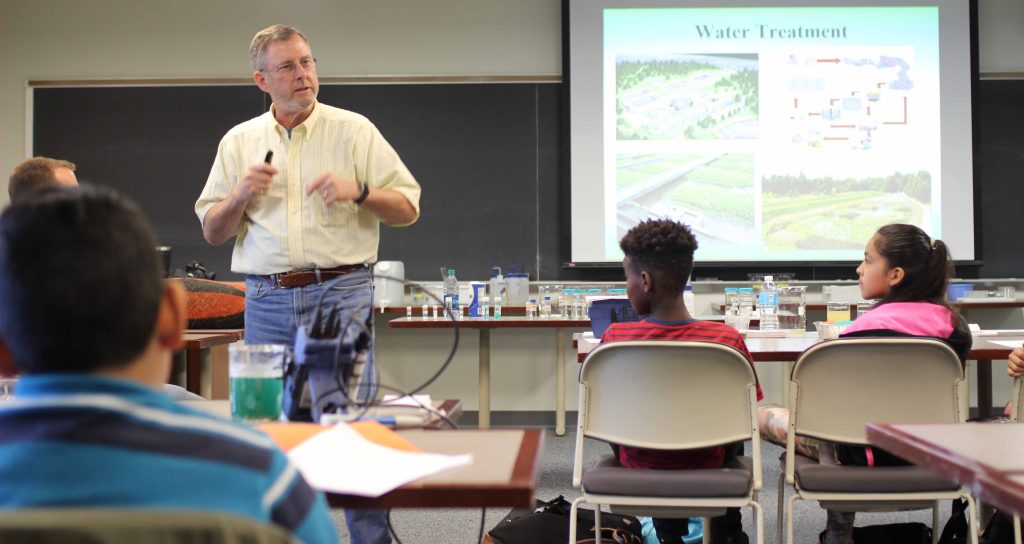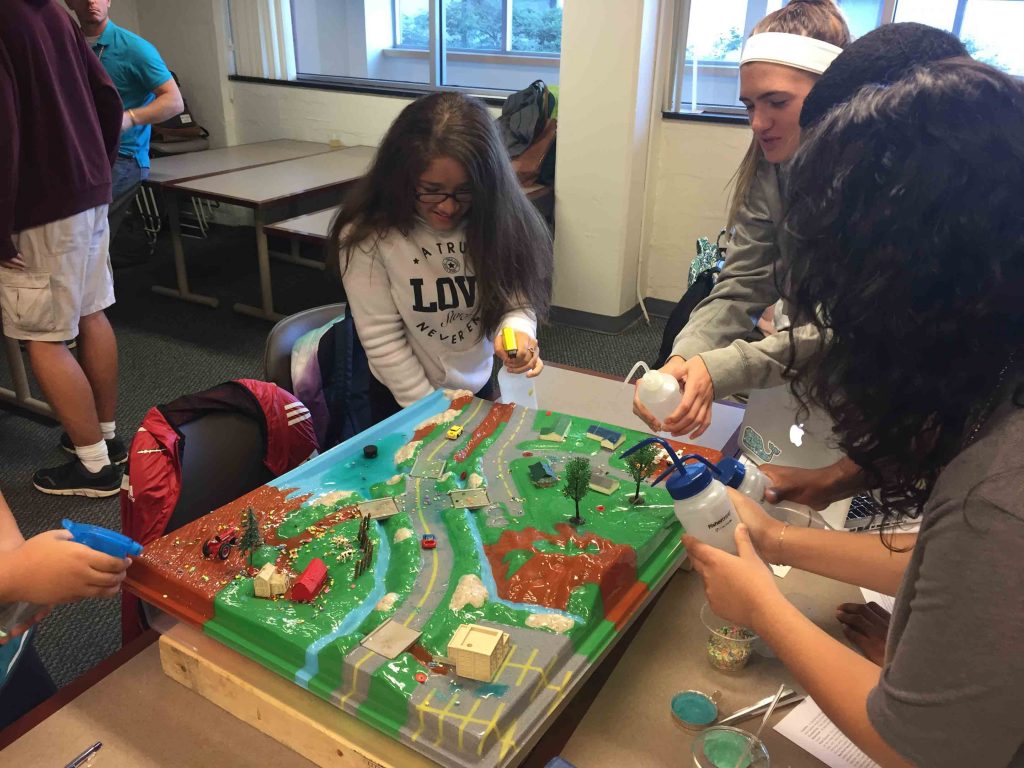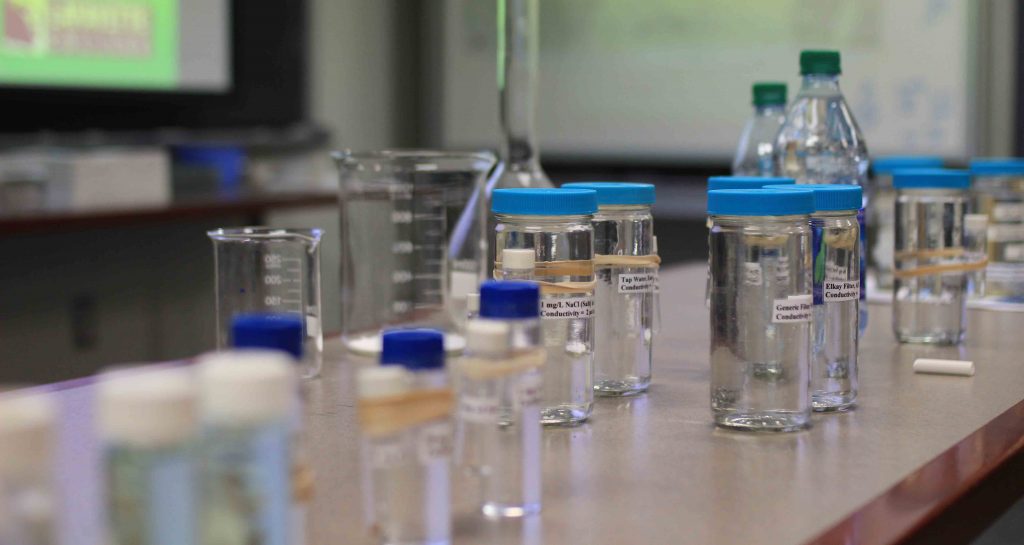By Stephen Wilson
As if decorating sugar cookies, a Lafayette engineering student sprinkles tiny confections, meant to represent soil, over a rural model. The confections land near homes and farms and alongside roadways.
Another engineering student then sprinkles blue bath salts on the streets to represent road salt and green bath salts on the land to represent fertilizers.
College students then hand spray bottles to fifth-graders from Cheston Elementary. The young pupils make it rain. Water slowly begins to flow, picking up the confections and salts and pooling in the model’s tiny harbor.
 The college student pulls the plug in the harbor to collect “polluted” water into a beaker.
The college student pulls the plug in the harbor to collect “polluted” water into a beaker.
If only dealing with real pollution were that easy.
But it is just what the elementary pupils need to understand the basics and pique their interest in college education.
Art Kney is passionate about these topics. As associate professor in the civil and environmental engineering department and director of the Center for Community Engagement, Kney wants his Lafayette students to pass on what they have learned to a community of students who are in need of extra motivation.
Cheston Elementary is one of two United Way Community Schools in Easton. United Way of the Greater Lehigh Valley is focused on leveling the playing field for schools where students face more barriers to success. The schools become a hub of services that include one-site medical and dental, food banks, clothing closets, and housing resources. These services can help prevent issues that distract from learning. Each school has a community and corporate partners. Together, the goal is to improve reading scores and prepare students for success in high school.

The Center for Community Engagement pilot program at Cheston focuses on enhancing educational outcomes of core curriculum by bringing Lafayette faculty, Cheston teachers, and both Lafayette and Cheston students together through cooperatively developed classroom-oriented learning modules. Lafayette students will be challenged to deliver content-rich lessons learned in ongoing Lafayette classes to elementary school children in classroom settings–at both Lafayette College and Cheston Elementary School.
“I’m hoping that other faculty on campus will see the tremendous benefit to their research, student learning, and community partnerships, and jump on board with curriculum development,” says Kney. “I am also hoping our community sees the benefit of our cooperative program and helps us identify funding sources to keep the program alive as well as expand it into other schools.”
Already planned are programs in Spanish, Asian studies, English, environmental studies, psychology, and biology. Kney has worked with Cheston Community School Coordinator Staci Zsilavecz, whose dedication to the elementary pupils is palpable.
Today fifth-graders are on campus for the inaugural program. They will take a tour, enjoy a dining hall lunch, visit the mechanical engineering lab, and learn a lesson in environmental engineering.

Kney is excited to engage the students and has prepared a PowerPoint lesson in a language they will understand, leveraging terms in the district’s “Leader in Me” program that uses Steven Covey’s Seven Habits for Highly Successful People.
“We want you to synergize with your friends by working as a team today,” Kney says, “and to begin with the end in mind as you create a hypothesis of what is going to happen.”
He then talks for a short time about college students in the room who are studying civil and chemical engineering, environmental science, and biology. Next comes a list of the greatest accomplishments by engineers.
His area of interest from that list is clean water.
“Our bodies are about 70 percent water,” he says. “We all need it to survive, but only 4 percent of the water on the planet is fresh, and of that amount less than 1 percent is in our streams and lakes. So keeping it clean is important.”

Kney shows the water cycle, emphasizing a lesson they are learning in class. He talks about common elements found in our water like calcium, magnesium, and potassium, and some common pollutants, like copper, bleach, and lead. Add to it bacteria and microorganisms.
Learning how to measure polluted water and clean it are the goals today.
At seven tables across the room are a mix of college teams and Cheston students. Each team has prepared a lesson to illustrate sources of pollution and how to measure the amount of pollution.
One team uses sprinkles, bath salts, and the rural model.
Others have Play-Doh, beakers of dirt, and bricks. Some have handouts while others have laptop presentations. All have turbidimeters to measure soil pollution or conductivity probes to measure salt pollution.
The lessons begin. Pupils are mixing, stirring, and measuring. The Lafayette students are beaming as things click and reframing when ideas miss. The fifth-graders have worksheets and “quizzes” at the end to test their understanding.

One group is using a crossword quiz of terms while other teams are using word searches and questions on a tablet.
More than the lesson, the elementary pupils are asking questions about college: Is it hard? Do you miss your family? How do you make friends? What’s a college class like? The college students answer, but more so they reassure them that college is a place that should be part of their future plans.
After 40 minutes, Kney grabs the class’s attention.
“So you have seen how pollution happens and how we measure it,” he says. “Now let’s talk about how to clean our water.”
He talks about wastewater and drinking water treatment processes. Kney throws a “silt sack” on a table to show how to use natural processes, like this bag of mulch designed to filter out salt and soil before water enters the waterway.
You can see he is in his element, sharing his passion, watching his students shine, and inspiring the next generation of engineers as they see beyond the fifth grade.
Although he is giving a pollution message, Kney is willing to get his hands dirty and is truly worth his salt. Luckily for all the students, there is no treatment for that.
 The college student pulls the plug in the harbor to collect “polluted” water into a beaker.
The college student pulls the plug in the harbor to collect “polluted” water into a beaker.


